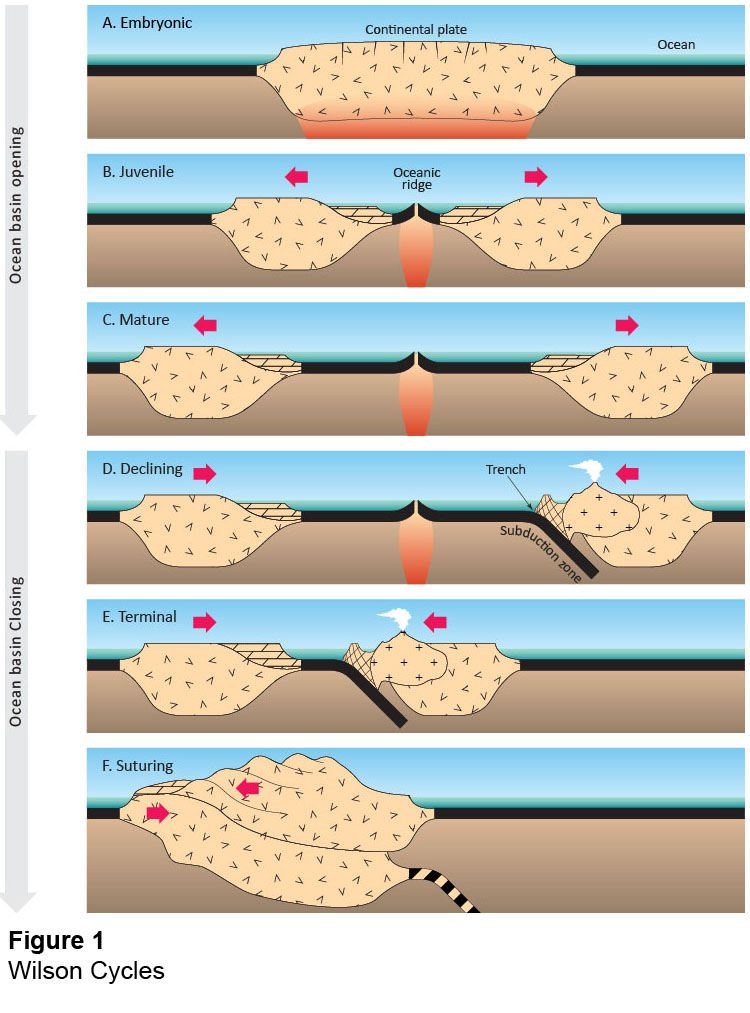AMS Ocean Studies

2.10 Wilson Cycles
A Wilson cycle consists of six stages: embryonic, juvenile, mature, declining, terminal, and suturing. The cycle begins because thick continental crust does not conduct heat as readily as thinner oceanic crust. A supercontinent that remains in one location for hundreds of millions of years acts like a blanket, retarding heat flow from Earth’s interior. This causes the mantle beneath the supercontinent to warm. As the underlying mantle warms, it expands, elevating the overlying continent and stretching the continental crust. Convection currents in the mantle also contribute to this stretching and eventually the crust fractures, forming a rift valley. This is Wilson’s embryonic stage (TID Figure 1A). As noted earlier in this chapter, a rift valley is an elongated topographic depression bordered by fractures (faults) in the bedrock. The African continent has been in its present location for about 200 million years and now stands about 400 m (1300 ft) higher than other continents as a consequence of the heating and expansion of the underlying mantle. Fracturing and some spreading of the crust produced the rift valleys of East Africa.

With rifting of the continental crust, the broken sides rise about a kilometer enclosing a valley that often fills with fresh water. In East Africa, long, deep lakes now occupy narrow rift valleys. Rift valleys gradually widen and eventually connect to the ocean and the freshwater lakes become narrow saline gulfs. This is happening now in the Red Sea and Gulf of California and marks the beginning of Wilson’s juvenile stage (TID Figure 1B). With continued lateral spreading of the rift valley, the divergent plate boundary widens and additional oceanic crust is generated signaling the mature stage of the Wilson cycle (TID Figure 1C). Today, the Atlantic is a mature ocean with geologically passive margins.
Subduction becomes more widespread around the border of the ocean basin during the declining stage of the Wilson cycle (TID Figure 1D). In time, cooling and the loss of volatiles increase the density of oceanic plates. Under the influence of gravity, these plates slide down and away from the bathymetric high of the mid-ocean ridge and sink into the asthenosphere at subduction zones. Today, the Pacific is the best example of a declining ocean with subduction zones forming the Pacific Ring of Fire. This is also now happening on a smaller scale in the South Atlantic (Scotia Arc near Antarctica) and in the West Indies (near Barbados). Typically an ocean basin widens for about 200 million years before subduction begins. As evidence of this, no oceanic crust has been found that is more than 200 million years old. Eventually, the basin begins to close as subduction rates (at trenches) exceed spreading rates (at mid-ocean ridges). For Earth as a whole, spreading must equal subduction—otherwise the planet would be shrinking or expanding. Over the subsequent 200 million years, the ocean basin continues to close and its sediment deposits are deformed and uplifted, creating mountain ranges on the newly assembled supercontintent at the site of the former ocean.
Following the declining stage of the Wilson cycle, the ocean basin closes through subduction as continents from opposite sides of the ocean basin bear down on one another and eventually collide. These events signal the final two stages of the Wilson cycle: the terminal and suturing stages. In the terminal stage, the continents are not yet touching but subduction of the intervening oceanic crust causes a narrowing of the sea separating the continents (TID Figure 1E). Volcanic eruptions, earthquakes, uplift, and mountain building accompany subduction of the oceanic crust. An example of this today is the African continent converging with the European continent producing the intervening Mediterranean Sea with nearby volcanism, earthquakes, and young rugged mountains (e.g., the Alps).
During the suturing stage, collision of the continents is complete and the intervening sea is gone (TID Figure 1F). The two colliding continental crusts, being less dense than the oceanic crust, do not subduct but rather override one another causing uplift and mountain building. Collision of the continents squeezes out the intervening ocean and causes subduction of oceanic crust. Today, the suturing stage is illustrated by the collision of the Indian and Eurasian plates generating the Himalayan Mountains. The Appalachian Mountains of eastern North America also formed in this way at the end of the previous Wilson cycle, about 450 million years ago.
An animation of Wilson Cycles is presented below: